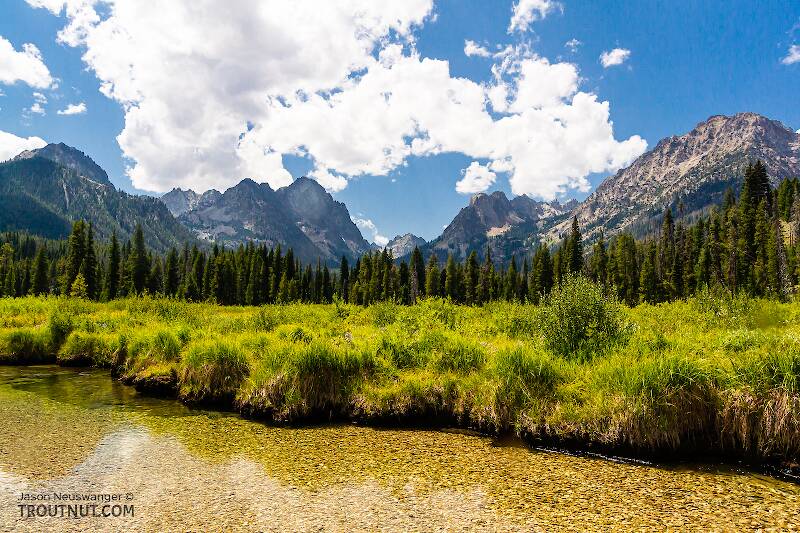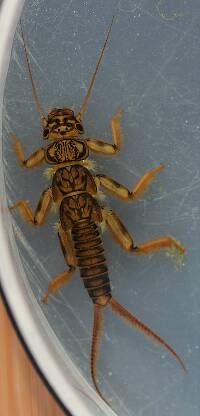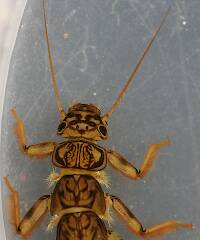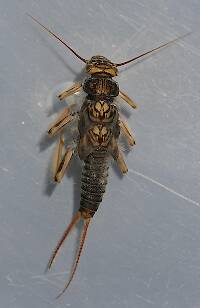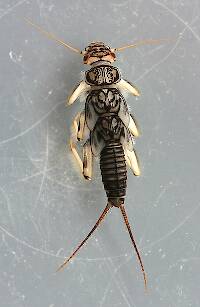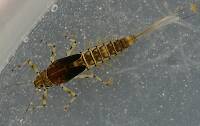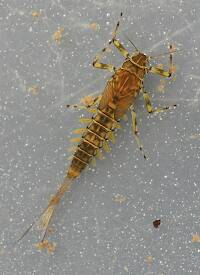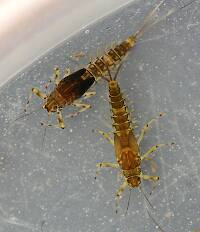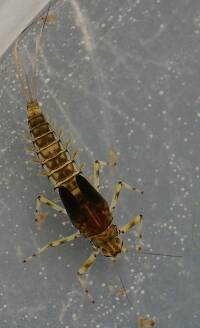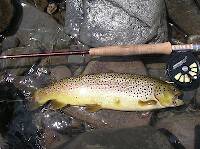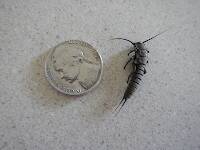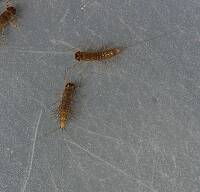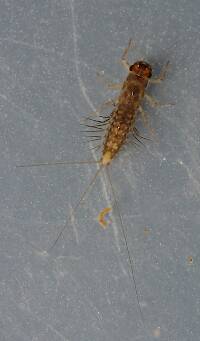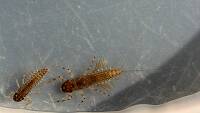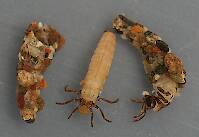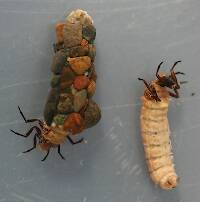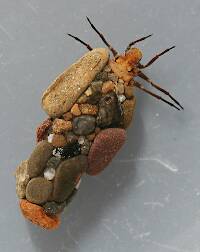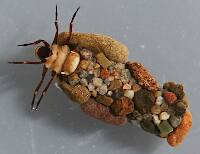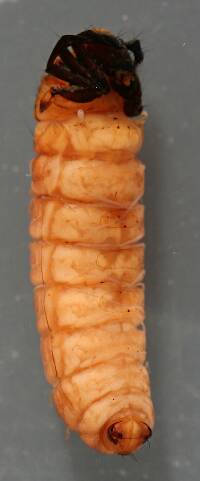
Blue-winged Olives
Baetis
Tiny Baetis mayflies are perhaps the most commonly encountered and imitated by anglers on all American trout streams due to their great abundance, widespread distribution, and trout-friendly emergence habits.
Featured on the forum

This is an interesting one. Following the keys in Merritt R.W., Cummins, K.W., and Berg, M.B. (2019) and Jacobus et al. (2014), it keys clearly to Ephemerella. Jacobus et al provide a key to species, but some of the characteristics are tricky to interpret without illustrations. If I didn't make any mistakes, this one keys to Ephemerella mucronata, which has not previously been reported any closer to here than Montana and Alberta. The main character seems to fit well: "Abdominal terga with prominent, paired, subparallel, spiculate ridges." Several illustrations or descriptions of this holarctic species from the US and Europe seem to match, including the body length, tarsal claws and denticles, labial palp, and gill shapes. These sources include including Richard Allen's original description of this species in North America under the now-defunct name E. moffatae in Allen RK (1977) and the figures in this description of the species in Italy.

Troutnut is a project started in 2003 by salmonid ecologist Jason "Troutnut" Neuswanger to help anglers and
fly tyers unabashedly embrace the entomological side of the sport. Learn more about Troutnut or
support the project for an enhanced experience here.
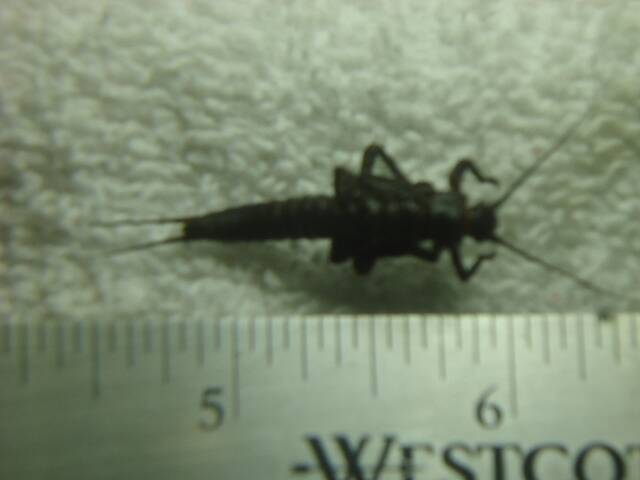
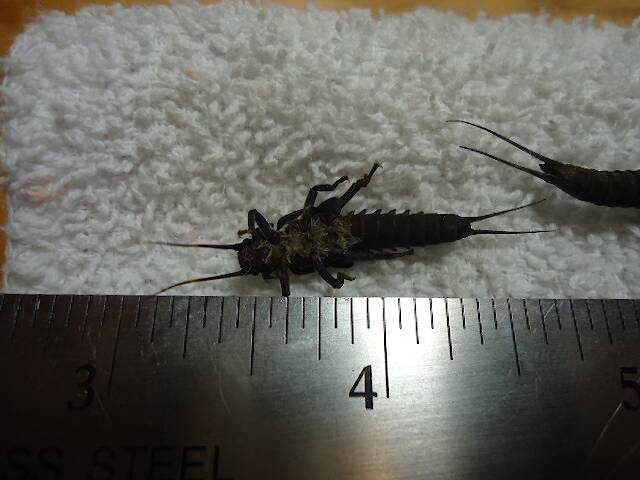
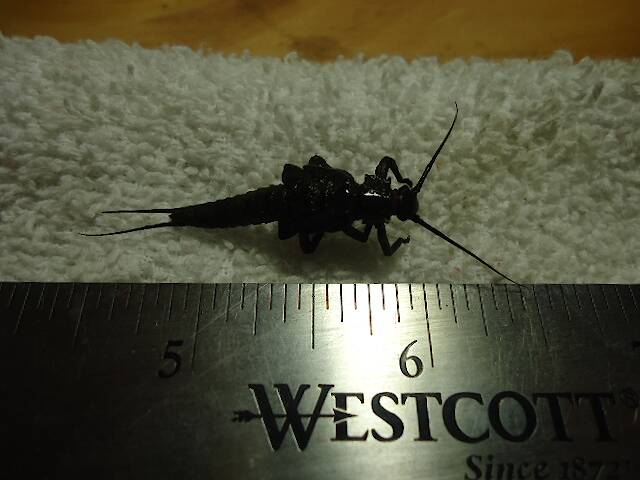
Smeador on Mar 29, 2014March 29th, 2014, 1:38 pm EDT
Collected these 2 from a warm-water, silt-laden stream in southside VA today. Been fishing this stream and collecting for 3 yrs. and have never seen this one.
I'm leaning towards P. dorsata.
Charcoal color.
Whitish, hairy-looking underneath - not continuous but consistant.
Antenna have 4 color "sections" black-brown-black-brown, ONLY 4 sections.
Help with ID???
I'm leaning towards P. dorsata.
Charcoal color.
Whitish, hairy-looking underneath - not continuous but consistant.
Antenna have 4 color "sections" black-brown-black-brown, ONLY 4 sections.
Help with ID???
Entoman on Mar 29, 2014March 29th, 2014, 5:06 pm EDT
Don't think so, Sandy. Notice the lateral projections (often called hooks or knobs on stoneflies) on the abdominal segments? Dorsata doesn't have these. Since they are smaller on the posterior segs, I believe this is probably a specimen of P. proteus. On biloba, the size and length of the hooks would be more uniform all they way to the 8th.
Anyway, nice find!
Anyway, nice find!
"It's not that I find fishing so important, it's just that I find all other endeavors of Man equally unimportant... And not nearly as much fun!" Robert Traver, Anatomy of a Fisherman
PaulRoberts on Mar 30, 2014March 30th, 2014, 4:09 pm EDT
It can take some looking to find Pteronarcys. They are easiest to locate by looking for large substrate pieces, for a few reasons I believe: They have mutli-year life spans so individuals are most apt to survive if they find large stable substrate. Such substrate also tends to collect and hold more allocthonous debris on which they feed. It seems habitat stability is important to Pteronarcys bc they don't drift very well, being heavy, cylindrical, and make no attempts to swim if dislodged. They roll up into a near ball and sink like rocks. Their lack of coloration may be camouflage too, giving them a drowned stick look.
So, if you want to find more, be sure to check the larger subsrate pieces in your stream -big boulders, and wood, that collects leaf pack. This is more work and lots of samplers don't bother. You'll also find other large stoneflies, Corydalids, and craneflies, and crayfish too.
So, if you want to find more, be sure to check the larger subsrate pieces in your stream -big boulders, and wood, that collects leaf pack. This is more work and lots of samplers don't bother. You'll also find other large stoneflies, Corydalids, and craneflies, and crayfish too.
Crepuscular on Mar 30, 2014March 30th, 2014, 6:02 pm EDT
It can take some looking to find Pteronarcys. They are easiest to locate by looking for large substrate pieces...
So, if you want to find more, be sure to check the larger subsrate pieces in your stream -big boulders, and wood, that collects leaf pack. This is more work and lots of samplers don't bother. You'll also find other large stoneflies, Corydalids, and craneflies, and crayfish too.
Good advice Paul. I have actually found them in old terrestrial beetle galleries in submerged logs.
PaulRoberts on Mar 30, 2014March 30th, 2014, 6:07 pm EDT
Good advice Paul. I have actually found them in old terrestrial beetle galleries in submerged logs.
That makes perfect sense, Eric. They like, or need, to be tucked away.
Entoman on Mar 30, 2014March 30th, 2014, 6:35 pm EDT
Interesting, guys. Sure different in my experience. I wonder if it has something to do with population density and survival schemes? Californica is found in large cobble substrate with water moving over it at a pretty good clip. They are found there in prodigious numbers and are very easy to find. Perhaps the Eastern species need better hides to protect them due to much smaller populations?
"It's not that I find fishing so important, it's just that I find all other endeavors of Man equally unimportant... And not nearly as much fun!" Robert Traver, Anatomy of a Fisherman
PaulRoberts on Mar 30, 2014March 30th, 2014, 7:58 pm EDT
I thought you might pop in with that very response. I've read similar descriptions about californica being more abundant and active. I was talking about my experiences with eastern P. on small to mid-sized streams. It always seemed that there just wasn't enough habitat to hold many P. in the streams I frequented. They'd could be in riffles, just under big substrate where presumably it's pretty dark and quiet.
Entoman on Mar 30, 2014March 30th, 2014, 9:09 pm EDT
Ha! You know me pretty well.:)
I knew you were talking about eastern critters. I was hoping to discuss the differences in habitat selection between these species that are virtually identical morphologically speaking. Since western pteronarcids can rely more on safety in numbers perhaps they can afford to be less picky about avoiding exposure? Just musing... Another oddity is population densities vs. distribution. It's strange that these species are polar opposites.
I knew you were talking about eastern critters. I was hoping to discuss the differences in habitat selection between these species that are virtually identical morphologically speaking. Since western pteronarcids can rely more on safety in numbers perhaps they can afford to be less picky about avoiding exposure? Just musing... Another oddity is population densities vs. distribution. It's strange that these species are polar opposites.
"It's not that I find fishing so important, it's just that I find all other endeavors of Man equally unimportant... And not nearly as much fun!" Robert Traver, Anatomy of a Fisherman
PaulRoberts on Mar 31, 2014March 31st, 2014, 3:53 pm EDT
Yes, it's a good question. I've always suspected that it's a habitat limitation. How deeply this is engrained in the respective species is an interesting question, These, like so many NA critters, are of a periglacial genus (family even) that likely diversified postglacially. What we are seeing are adaptations -manifestations of prehistory. There is no one Pteronarcys anymore. Pure musing. Dunno where such thoughts might lead, just ... cool stuff. Stretches the imagination.
Curious, if you drop californica into the current does it ball up and plummet due to sheer gravity? Or are they more active? It is interesting that diff species of stonefly (and other macroinverts) respond differently when flushed into the drift. It says something about where they live, how the live, how trout perceive them, and how we might tie and fish imitations. Such potential links between fishing and the real world are what's so cool.
Curious, if you drop californica into the current does it ball up and plummet due to sheer gravity? Or are they more active? It is interesting that diff species of stonefly (and other macroinverts) respond differently when flushed into the drift. It says something about where they live, how the live, how trout perceive them, and how we might tie and fish imitations. Such potential links between fishing and the real world are what's so cool.
Entoman on Mar 31, 2014March 31st, 2014, 8:24 pm EDT
My experience with californica is they ball up in the hand, not in the water. I've experimented with them quite a bit. My theory is that they behave somewhat like pill bugs? It's a predator response not a lost footing one. I found that if you hold them before dropping in the water they will often stay curled for quite awhile until they are sure they are safe from the critter that grabbed them. When gently shaken off rocks held low in the water they usually drift arched the other way with their legs held out looking to get ahold of something. They will tumble somewhat but mostly they will right themselves at some point. If I then reached into the water to grab them or touch them, they often curled up again. Anyway, that's why I tie my imitations on straight hooks or slightly bent up, at least for californica. That's my excuse anyway, as heavily curved long shank hooks are much more prone to miss fish in my experience. :)
I think you are on to something about adaption being the reason for their radically different lifestyles on the two coasts. Back East they ended up in more rivers but with smaller populations. Perhaps their lack of numbers is why they are prone to seek out more protective homes? The westerners aren't in a lot of rivers, but of those where they are present, their numbers can be mind boggling some years.
I think you are on to something about adaption being the reason for their radically different lifestyles on the two coasts. Back East they ended up in more rivers but with smaller populations. Perhaps their lack of numbers is why they are prone to seek out more protective homes? The westerners aren't in a lot of rivers, but of those where they are present, their numbers can be mind boggling some years.
"It's not that I find fishing so important, it's just that I find all other endeavors of Man equally unimportant... And not nearly as much fun!" Robert Traver, Anatomy of a Fisherman
PaulRoberts on Mar 31, 2014March 31st, 2014, 9:59 pm EDT
My experience with californica is they ball up in the hand, not in the water. I've experimented with them quite a bit. My theory is that they behave somewhat like pill bugs? It's a predator response not a lost footing one. I found that if you hold them before dropping in the water they will often stay curled for quite awhile until they are sure they are safe from the critter that grabbed them. When gently shaken off rocks held low in the water they usually drift arched the other way with their legs held out looking to get ahold of something. They will tumble somewhat but mostly they will right themselves at some point. If I then reached into the water to grab them or touch them, they often curled up again. Anyway, That's why I tie my imitations on straight hooks or slightly bent up, at least for californica.
Ah! Could be "observer effect" in my case.
Perhaps their lack of numbers is why they are prone to seek out more protective homes?
All conjecture though since the evidence is just anecdotal. Interesting ponderings though.
Jmd123 on Apr 1, 2014April 1st, 2014, 1:04 pm EDT
My experiences here in Michigan are that Pteronarcys are always associated with good-sized pieces of wood, in fact they will work their way into crevices and cracks and therefore not be collected by conventional stream sampling methods (dip net, Surber sampler, Hess sampler, etc.). You have to look into the wood.
This experience was repeated for me two summers ago when I first taught Field Biology at ACC. We took a field trip to the Pine River at one of my favorite fly fishing spots and attempted to seine fish, which we unfortunately didn't. I also raked around pretty good with a dip net in all types of microhabitats and didn't come up with any big nymphs or larvae. Well, a piece of wood about the size of a softball accidentally came home with the seine net, and as it was drying on my deck a big black Pteronarcys nymph crawled out of it and died. Wouldn't have caught one otherwise...
This also explains their low abundance in these parts. I see a few of these big guys on the wing each spring in June in the evening on both the Rifle and the Pine, and there are a fair amount of logs and etc. in each stream, but not nearly as extensive as gravel beds, or silt-bottomed holes, or smaller woody debris which all support their share of nymphs and larvae.
Jonathon
This experience was repeated for me two summers ago when I first taught Field Biology at ACC. We took a field trip to the Pine River at one of my favorite fly fishing spots and attempted to seine fish, which we unfortunately didn't. I also raked around pretty good with a dip net in all types of microhabitats and didn't come up with any big nymphs or larvae. Well, a piece of wood about the size of a softball accidentally came home with the seine net, and as it was drying on my deck a big black Pteronarcys nymph crawled out of it and died. Wouldn't have caught one otherwise...
This also explains their low abundance in these parts. I see a few of these big guys on the wing each spring in June in the evening on both the Rifle and the Pine, and there are a fair amount of logs and etc. in each stream, but not nearly as extensive as gravel beds, or silt-bottomed holes, or smaller woody debris which all support their share of nymphs and larvae.
Jonathon
No matter how big the one you just caught is, there's always a bigger one out there somewhere...
Oldredbarn on Apr 2, 2014April 2nd, 2014, 7:16 am EDT
Jonathon,
In Hazen Miller's book, "The Old Au Sable", he talks about what the river must have been like before anyone got there other than the native Americans...Nearly clogged with woody debris...
Over the years of logging and now chain saw carrying canoe livery owners, the wood is gone. A few years back the Angler's of the Au Sable started a program where they helicoptered whole trees and dropped them in the river.
Some of us complained after they seemed to be dropping them in our favorite holes. :) A few years back we had an ungodly heavy melt and rain around opening day and the rivers were out of their banks...Some of the trees disappeared.
I asked a friend where they had gone, and he said, "The Mio pond."
There were some nice articles in the Angler's newsletter, "The Riverwatch", back in the 90's that were written by some of the biologists nosing around the river. They explained that trout can't live in sterile water....The whole cycle needs decay and food stuff for all our favorite bugs.
They were even knocking around an idea to purchase fall leaf rakings from municipalities and dump them in the river...
George Griffith used to say that we love the river to death. Everyone buys cabins and mows down to the stream because they want to see it from their window...This takes cover away from the stream and leaf fall etc...Warming up the creek and doing away with hiding areas for the fish etc.
Tim Neal can speak to the fishing prior to Grayling upgrading their sewer/run-off system in town...After they cleaned it up, so the story goes, the weeds in the river decreased...Some claim the fishing hasn't been the same since...One guy claimed that you could make the river too clean for trout, meaning the bugs need something to eat and in turn feed the fish etc.
Next time you need to find some stonefly nymphs I'll take you to a stretch that Rusty Gates called, "Stonefly Alley".
Spence
In Hazen Miller's book, "The Old Au Sable", he talks about what the river must have been like before anyone got there other than the native Americans...Nearly clogged with woody debris...
Over the years of logging and now chain saw carrying canoe livery owners, the wood is gone. A few years back the Angler's of the Au Sable started a program where they helicoptered whole trees and dropped them in the river.
Some of us complained after they seemed to be dropping them in our favorite holes. :) A few years back we had an ungodly heavy melt and rain around opening day and the rivers were out of their banks...Some of the trees disappeared.
I asked a friend where they had gone, and he said, "The Mio pond."
There were some nice articles in the Angler's newsletter, "The Riverwatch", back in the 90's that were written by some of the biologists nosing around the river. They explained that trout can't live in sterile water....The whole cycle needs decay and food stuff for all our favorite bugs.
They were even knocking around an idea to purchase fall leaf rakings from municipalities and dump them in the river...
George Griffith used to say that we love the river to death. Everyone buys cabins and mows down to the stream because they want to see it from their window...This takes cover away from the stream and leaf fall etc...Warming up the creek and doing away with hiding areas for the fish etc.
Tim Neal can speak to the fishing prior to Grayling upgrading their sewer/run-off system in town...After they cleaned it up, so the story goes, the weeds in the river decreased...Some claim the fishing hasn't been the same since...One guy claimed that you could make the river too clean for trout, meaning the bugs need something to eat and in turn feed the fish etc.
Next time you need to find some stonefly nymphs I'll take you to a stretch that Rusty Gates called, "Stonefly Alley".
Spence
"Even when my best efforts fail it's a satisfying challenge, and that, after all, is the essence of fly fishing." -Chauncy Lively
"Envy not the man who lives beside the river, but the man the river flows through." Joseph T Heywood
"Envy not the man who lives beside the river, but the man the river flows through." Joseph T Heywood
PaulRoberts on Apr 2, 2014April 2nd, 2014, 3:59 pm EDT
Spence, excellent post. Our rivers aren't what they once were. Pteronarcys is likely a relict in most eastern streams.
Not only do "large substrate pieces" house big trout foods, they house big trout too.
Not only do "large substrate pieces" house big trout foods, they house big trout too.
Jmd123 on Apr 2, 2014April 2nd, 2014, 4:24 pm EDT
Spence, the heavily canoed Rifle is regularly cleaned of logs so the floaters can go down...so there goes much of that habitat, though I know a few nice logs in the reaches I fish.
There is also a spot on the Pine that used to have large old beaver meadows which have been removed. This spot is not only nearly devoid of good habitat (though it holds a few small fish), there are a whole bunch of dead ash trees nearby killed by the emerald ash borer (a MAJOR pest here in MI if you're not familiar with it). It seems to me that someone from the Forest Service could just go out there with a chainsaw and drop many if not most of them into the stream and create a hundred times more habitat in there than currently exists. I have no doubt whatsoever that the number and size of fish in this reach would increase dramatically.
Jonathon
There is also a spot on the Pine that used to have large old beaver meadows which have been removed. This spot is not only nearly devoid of good habitat (though it holds a few small fish), there are a whole bunch of dead ash trees nearby killed by the emerald ash borer (a MAJOR pest here in MI if you're not familiar with it). It seems to me that someone from the Forest Service could just go out there with a chainsaw and drop many if not most of them into the stream and create a hundred times more habitat in there than currently exists. I have no doubt whatsoever that the number and size of fish in this reach would increase dramatically.
Jonathon
No matter how big the one you just caught is, there's always a bigger one out there somewhere...
Quick Reply
Related Discussions
Topic
Replies
Last Reply
1
Jan 29, 2016
by Martinlf
by Martinlf
1
Oct 28, 2008
by GONZO
by GONZO
1
May 11, 2007
by Troutnut
by Troutnut
4
Sep 4, 2012
by Entoman
by Entoman

